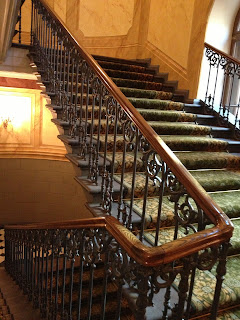It is housed in a historical building completed in 1855 as Riga's first stock exchange (the Bourse, or Birža in Latvian.) Riga was at the time the third largest city in the Russian Empire, after Moscow and St. Petersburg, and one of the main ports and train hubs in the Empire. Its economy was growing and diversifying, and, as it did so, the influence of the old Baltic German guilds began to decline and a Latvian middle class arose. The effort to build the Bourse reflected these economic changes and related aspirations -- it resulted in a prominent location (on Doma Laukums, across from the Riga Cathedral) and a space large enough to house not just the stock exchange, but also meeting rooms and other places to conduct business, including shops on the ground floor.
It must have been an impressive place even then -- look at the now restored staircase in the building:
And these halls, at the time, were for business and socializing:
 |
| Venetian Hall Bourse Museum |
 |
| Makart Hall Bourse Museum |
Meanwhile a movement of National Awakening began and resulted in Latvia's independence in 1918. National institutions began to sprout up, and Latvia's Museum of Foreign Art was established in 1920, with art donated by some of the same individuals who conducted business in the Bourse. This collection, however, was held not at the Bourse but in Riga's Castle, and the Bourse continued its role as an economic hub right until Soviet occupation in 1940. During Soviet times, the Bourse housed some local cultural offices and suffered from neglect typical of the times, as well as damage from a fire in 1980.
Restoration began in 2008, with the goal of moving the collection of the Latvian Foreign Art Museum from the Castle to this space, and also to expand the concept of the museum and provide a space for exhibitions and contemporary art. I love the results. This is the atrium of the new Museum, with a deconstructed gondola hanging from the rafters:
The gondola may be a reference to the style of the building, which is described as that of a Venetian Renaissance palazzo. The atrium itself is a new space, resulting from the enclosure of what was at one point a passage for people and cars.
The upper floors now hold an interesting collection of Western and Oriental art. The Western collection includes paintings from the 16th to the 19th century (displayed in the Venetian and Makart Halls pictured above), primarily by Dutch and German painters. There are a number of beautiful still-lives; a nice Monet, titled "Winter Landscape"; and some depictions of biblical stories, including a large painting by the Italian master Luca Giordano, "Solomon Worshipping False Gods," below:
But my favorite was this portrait of an old woman by Balthasar Denner, from the first half of the 18th century:
Adjacent to the Venetian Hall is the Western Gallery of the Museum, below:
This holds a major collection of Meissen porcelain and other decorative objects, such as the cabinet below, whose front is inlaid with tortoise shell:
The Western Gallery also includes a silver collection that has an interesting and moving origin. When the Museum of Foreign Art was established, soon after World War I, the new Latvian state was impoverished from the war and asked citizens to donate silver as a way to bolster the state's reserves -- and many did. In the chaos of rebuilding, accurate records of donations were not kept, and some of the silver that made its way into the collection of the original Foreign Art Museum may well be from these original donations to the state's coffers.
 |
| Silver Family Tree |
 |
| Donated Silver Objects |
One floor below the Western Gallery and the Venetian and Makart Halls -- in the space that once held the offices of the Bourse -- is the Museum's Oriental Gallery, which includes decorative objects from China, Japan, India, and Indonesia. This collection also originates from donations at the founding of the Museum, although it was expanded during the 1970s. It features some very interesting objects, including these amazing ivory carvings from 19th century India:
The ground floor of the Museum provides a space for rotating exhibits. There were two very different exhibitions when I visited: one on Romanticism and 19th century paintings, and one by a contemporary Italian/Romanian artist. Any museum that can do all of this at once is a pretty interesting place.






























